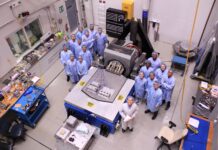The Evolv1 building is the newest addition to the David Johnston Research and Technology Park and has recently been named the first building in Canada to receive a net-zero carbon building design certification. Designed by, Cora Group and Stantec Inc in partnership with EY Canada, Sustainable Waterloo Region and the Technology Park, the Evolv1 office building will measure 110 000 square feet, be three storeys tall and will actually produce more energy than it consumes.
A net-zero building represents a type of building that has a very low impact on the environment, whether it is because it has net-zero site or source energy consumption, carbon conversion, greenhouse gas (GHG) emissions or cost of energy. A net-zero carbon building is defined as a building that succeeds in compensating for all the carbon it uses and that is embedded within its construction materials and methods with the off-grid production of its own carbon-free renewable energy for heating, cooling and electricity.
To do this, Evolv1will have roof-top solar panels as well as panels on sections of the parking lot. These will supply the building with renewable solar energy. Geothermal energy will also supply the building. This is renewable heat energy that is produced underground.
Evolv1 is not only producing its own energy on-site, but its design allows it to reduce the total energy that it uses for heating and cooling with the installation of triple-glazed windows (among other features). These are windows that are triple coated in a thin metal film that reflects infrared and ultraviolet light, keeping the heat inside during the winter and outside during the summer. The panes of glass are separated by an inert gas, which is a heavy gas that will decrease convective heat loss between panes, thus decreasing the heat flow or conductivity of the window. In addition to energy efficiency, Evolv1 is also designed to be water efficient. The installation of a living wall will compose part of the building’s grey water recycling system, designed to minimize the consumption of high-quality potable water throughout the building.
These features of Evolv1 are so important because rising concerns over the warming planet and the exhausting of fossil fuel sources are urging renewable low-carbon energies to become the planet’s main energy sources as part of a more sustainable energy framework. In Canada, energy for the commercial and institutional sectors accounted for 12.5% of total GHG emissions in 2015. This is mainly because the energy used to fuel these sectors mainly comes from high-carbon sources such as oil and natural gas.
In order to reduce the GHG emissions of the commercial and institutional sectors, the Pan-Canadian Framework on Clean Growth and Climate Change plans to introduce “net-zero” ready building codes that are scheduled to be implemented for new constructions and retrofitted buildings and homes by 2030. Until then, a net-zero design for new buildings is encouraged, but is ultimately an institutional decision.
Net-zero carbon buildings will drastically reduce the high-carbon energy consumption of the commercial and institutional sectors aiding in a transition toward a 100% renewable energy framework. As fossil fuels continue to deplete, renewable energy sources will increase in demand and lower in price, and this will subsequently increase the attractiveness of net-zero building options.
Evolv1 should serve as a model building in the Canadian renewable energy transition, as buildings like this demonstrate that designing a building that does not rely on any fossil fuel energy and has minimal environmental impact is possible and can be done.

































